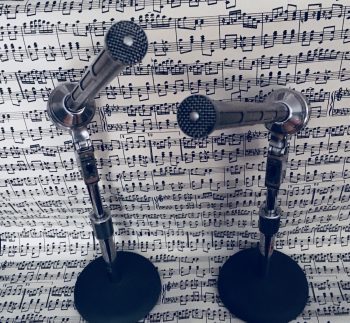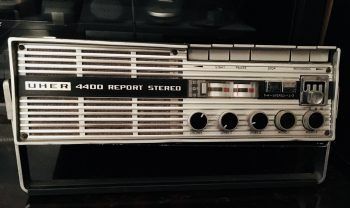by Michael Liss

How do you raise kids in an increasingly harsh and atonal world?
We all have our templates for seeking harmony. Mine were my own parents. They were not performing artists or even musicians; neither played an instrument (I think the kazoo doesn’t qualify), and neither could sing. But, as listeners, they were virtuosos. Classical, of course, but also big band and swing, boogie-woogie and jazz, klezmer, folk and protest songs. My father even harbored a secret passion for some pretty hardcore mountain music—the real thing, serious pickin’ and fiddlin’ without the Nashville gloss. My sister and I think he gave this up, along with drinking and smoking, when he met my mother.
Then, there was opera. I’ve written before about being tied to a chair in the Orchestra section of the old Met when my legs were still too short to make it all the way to the floor. It was all true: I saw Tosca jump off the parapet, and Madame Butterfly do herself in, and Mimi tragically pass, and Violetta tragically pass, and Radames and Aïda jointly and severally tragically pass, and Baron Scarpia and Don Giovanni not-so-tragically pass. All that passing was inescapable;  to quote Bugs Bunny in the towering “What’s Opera Doc?” (as even he passed, a victim of Elmer’s spear and magic helmet), “What did you expect in an opera, a happy ending?”
to quote Bugs Bunny in the towering “What’s Opera Doc?” (as even he passed, a victim of Elmer’s spear and magic helmet), “What did you expect in an opera, a happy ending?”
In retrospect, I should have been honored that my parents had such confidence in my emotional stability that they felt assured I could cope with all that passing. In the moment, however, I don’t think it ever entirely registered with me, especially since all the adults would then cheer wildly. Brava, she’s dead?
Of course, one couldn’t spend all one’s days in the stalls, but the music didn’t stop when the fat lady sang. It surrounded you. At home there was a NASA-like command center featuring a lot of ten-stop switches, open-reel tape decks, a variety of vacuum-tubed paraphernalia, and multiple sets of mics and speakers strategically placed through the apartment. Not unlike the Pyramids, the design and construction phase of this involved immense human labor and suffering, a variety of exotic curses, and the discovery of some unexpected talents—my mother proved to be extraordinarily gifted with a soldering iron.
On the road, whether driving or actually having arrived at a destination, the challenges were different. You can’t lug half a ton of audio equipment with you, even in a car with a trunk the size of a swimming pool. As for sound quality, car radios were for keeping cars company, so they wouldn’t be lonely, and not for people. Besides, if you didn’t like what was on WQXR, you were going to be out of luck. Let me just add that silence in an automobile, in which you were a captive, seat-belted audience, was not always a blessing, as Nature abhors a vacuum, and my Dad would fill it.
 Into the breach stepped the “Miracle in a Matchbox” Uher 4400 Report Stereo, a compact, battery powered, five-inch reel, multiple-speed tape deck. This machine was not only versatile, it was actually cool (they used it in the TV version of “Mission Impossible”). Since the Uher could go anywhere, it replaced the scorned car radio sound with “Parent” mixtapes.
Into the breach stepped the “Miracle in a Matchbox” Uher 4400 Report Stereo, a compact, battery powered, five-inch reel, multiple-speed tape deck. This machine was not only versatile, it was actually cool (they used it in the TV version of “Mission Impossible”). Since the Uher could go anywhere, it replaced the scorned car radio sound with “Parent” mixtapes.
Here’s where the fun came in—how to arrange the playlists. The five-inch reels created a challenge; even when recorded at half speed, they had a maximum 45 minute run time per side. Opera just didn’t fit (since the Statute of Limitations has run, I now can say I wasn’t terribly upset about that.) Nor did a lot of the rest of the classical oeuvre—either too short or too long. Very often, Beethoven, Brahms, and the gang showed a lack of foresight when it came to the importance of hitting that 45-minute mark, or an exact fraction of it. Take the Saint-Saëns Symphony No. 3: powerful, but 37 minutes. Dad-favorite Mendelssohn Violin Concerto in E Minor, or mine, the Mozart Clarinet Concerto in A Major? Both 29 minutes. That’s a lot of extra tape to try to fill without constantly adding snippets from the Polovtsian Dance No. 2 by Borodin.
The situation demanded creativity, and here is where my parents truly excelled. Yes, they were dedicated to the real adult stuff—the brown liquor of staffs and clefs and notes and intimidating sopranos. And they never wanted to infantilize their children: once we got out of the Itsy Bitsy Spider and Sing a Song of Sixpence phase, if they enjoyed it, then so should we. But they also liked to have fun (with a purpose, of course), and therein came a chance for a little cultural-political-musical proselytizing.
Mom and Dad were devout New Deal Liberals. They held to a bunch of antique ideas, like the unbreakable connection between Labor and the Democratic Party, freedom of speech and the press, civil rights, and wars being generally bad things, unless fought for good reasons. And they wanted to pass it on.
So, when there wasn’t enough room on those reels for Tchaikovsky or Sibelius, they threw in a bit of Pete Seeger, a little Paul Robeson, and, for extra flavor, a schmear of Allan Sherman. Just a touch of subversiveness amidst all that solemnity, a peek behind the parental curtain, like Bug’s grin in Rhapsody Rabbit.
There was a kind of magic to all this. Pete, both in solo and with The Weavers, drew on a tremendous traditional songbook filled with the music of causes and ordinary folks, such as When the Saints Come Marching In, Last Night I Had the Strangest Dream, 16 Tons, Brother Can You Spare a Dime, Pay Me My Money Down, Waist Deep In the Big Muddy, and The Rock Island Line. With Lee Hays, he wrote The Hammer Song, later popularized by Peter, Paul and Mary, and recorded by artists as diverse as Trini Lopez and Johnny Cash. Paul Robeson’s mighty bass-baritone lit up Ballad for Americans, The House I Live In, Old Man River, and Joe Hill. And Allan Sherman was just a goofball. He sang about Muddahs and Faddahs, Harvey and Sheila, and Hungarian Goulash No. 5. My parents didn’t mind a little silly.
Sadly, we lost them way too soon, but both my sister and I, with the cooperation of our tolerant spouses, thought we should keep with tradition. My kids were raised on all of the above. We played our video of “The Weavers: Wasn’t That a Time” so often we wore it out. We added Marriage of Figaro and Rabbit of Seville (operas with happy endings), sang Burl Ives, Chattanooga Choo Choo, and We’re Your Friends from The Jungle Book (I provided the questionable bassline). They got early training in conducting from Stokowski himself in Long Haired Hare. And what sophisticated childhood would be complete without Tom Lehrer’s “The Elements” and “Poisoning Pigeons in the Park”?
It was a perfect fit, because serendipitously, both my children (and my sister’s) showed some musicality, perhaps indicating a previously hidden ancestral gene expressing itself in a later generation. One very early indicator: when my daughter was just a peanut, barely talking, she would wait for the chorus in Pete and Lee Hays’ “Kisses Sweeter Than Wine” and squeak out “WINE!” on cue, and with the correct pitch. Two decades later, she’s a Mahler enthusiast who hopes to sing Tosca.
Puccini and The Weavers. Somehow that just seems right. Our recording of “Kisses” has Pete and Ronnie Gilbert the soloists, Lee Hays and Fred Hellerman joining in the chorus. A couple goes from young love to old—first kiss, marriage, working their farm, raising their kids, having grandchildren, and then looking back in gratitude.
“Now that I’m old and ready to go
We get to thinkin’ what happened a long time ago
We had a lot of kids, trouble and pain
But, oh Lord, we’d do it all again”
The four of us were together last weekend for dinner and then a seriously competitive game of Hearts, and our kids are still singing the same songs, just with grown-up voices. Their grandparents would be pleased. They probably would have joined in the refrain.
“Oh kisses sweeter than wine
Oh kisses sweeter than wine”
